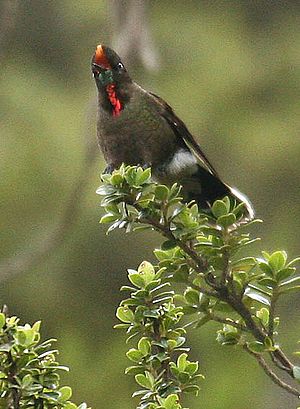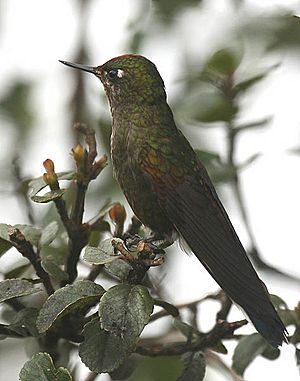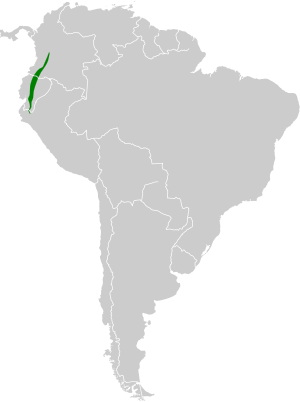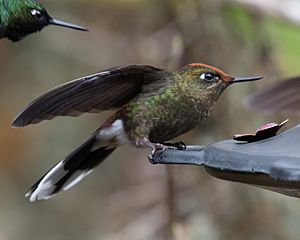Rainbow-bearded thornbill facts for kids
Quick facts for kids Rainbow-bearded thornbill |
|
|---|---|
 |
|
| Male in Yanacocha Reserve, Ecuador | |
 |
|
| Female in northwest Ecuador | |
| Conservation status | |
| Scientific classification | |
| Genus: |
Chalcostigma
|
| Species: |
herrani
|
 |
|
The rainbow-bearded thornbill (Chalcostigma herrani) is a type of hummingbird. It belongs to a group of hummingbirds called "coquettes." You can find this colorful bird in Colombia, Ecuador, and Peru.
Contents
How Scientists Name and Group Animals
Scientists formally described the rainbow-bearded thornbill in 1846. Two French bird experts, Adolphe Delattre and Jules Bourcier, named it. They found specimens near Pasto in southwest Colombia.
The bird's scientific name, Chalcostigma herrani, has a special meaning. Chalcostigma comes from Greek words meaning "bronze mark." The name herrani honors Pedro Alcántara Herrán. He was a general and important leader from Colombia.
There are two main types, or subspecies, of the rainbow-bearded thornbill:
- C. h. tolimae
- C. h. herrani
What Does the Rainbow-Bearded Thornbill Look Like?
The rainbow-bearded thornbill is a small bird. It is about 10 to 12 centimeters (4 to 5 inches) long. Males weigh around 6.2 grams (0.22 ounces). Females are a bit lighter, at about 5.6 grams (0.20 ounces). Both male and female birds have a short, thin bill that looks like a needle.
Adult males are mostly a shiny bottle green color. They have a white spot behind each eye. Their forehead and top of the head are a reddish-brown color. Their main wing feathers are black. The lower back is coppery, and the feathers under their tail are white.
The tail is forked and blue-black. It has bright white tips on the corners. You can see these white tips best when the bird is flying. The most amazing part is its "beard," called a gorget. This gorget shows a mix of colors. It goes from green to turquoise, then yellow, and finally red at the bottom. The bird's feet are black.
Adult females look similar to males. However, their lower belly and undertail feathers are pale yellowish. Their colorful gorget is much smaller. Young birds look like adult females. But young males have a completely dark throat. The C. h. tolimae subspecies looks very much like the main type. It is just a bit darker overall, and its gorget is longer.
Where the Rainbow-Bearded Thornbill Lives
The main type of rainbow-bearded thornbill lives in the Andes mountains. You can find it in Colombia, Ecuador, and northern Peru. The C. h. tolimae subspecies lives only in the Nevado del Tolima area of Colombia.
These birds live in high places. In Colombia, they are usually found between 2,700 and 4,100 meters (8,900 to 13,500 feet) high. In Ecuador, they live between 2,800 and 3,700 meters (9,200 to 12,100 feet). They prefer paramo, which is open land with bushes and small groups of trees. They also like gullies with thick ferns and bromeliad plants.
Behavior and Habits
Bird Movements
The rainbow-bearded thornbill does not migrate. It stays in the same area all year round.
What the Bird Eats
This hummingbird mainly drinks nectar from small flowers. These flowers grow on low bushes and shrubs. The bird often holds onto the flower while it feeds. It also eats insects when it can find them.
Rainbow-bearded thornbills usually look for food alone. They are very protective of their feeding spots. They will chase away other birds that try to get their food. This happens even if the other birds are much bigger. They do not let other hummingbirds feed near them, even on large trees with lots of fruit.
Reproduction and Life Cycle
Scientists do not know much about how the rainbow-bearded thornbill breeds. It seems their breeding season includes July to September. No one has fully described their nest yet. One report mentioned a nest with three eggs. This is unusual, as hummingbirds almost always lay two eggs.
Bird Sounds
There are not many recordings of the rainbow-bearded thornbill's calls. What might be its song is a repeated, low-pitched sound. It sounds like "cheet-dee-dee-cheet."
Conservation Status
The IUCN (International Union for Conservation of Nature) says the rainbow-bearded thornbill is of "Least Concern." This means it is not currently in danger of disappearing. It lives across a large area. However, we do not know how many of these birds there are. Their numbers are thought to be going down. No specific threats have been found for this species. People usually describe it as rare in some places, but common in others.
See also
 In Spanish: Colibrí de Herrán para niños
In Spanish: Colibrí de Herrán para niños



